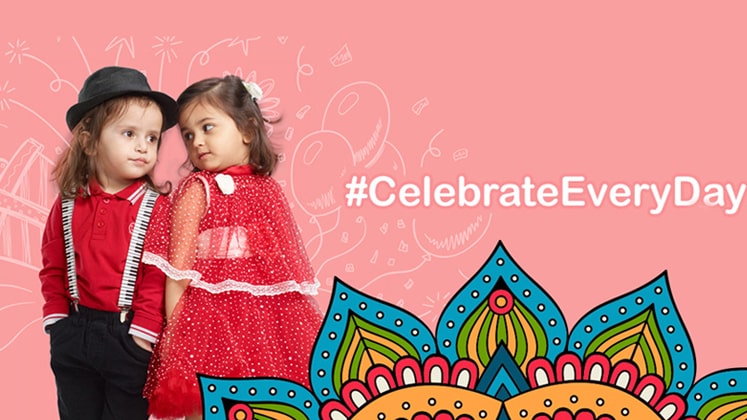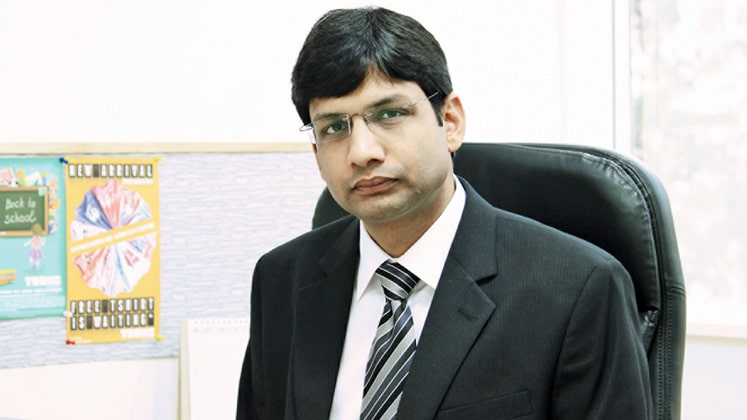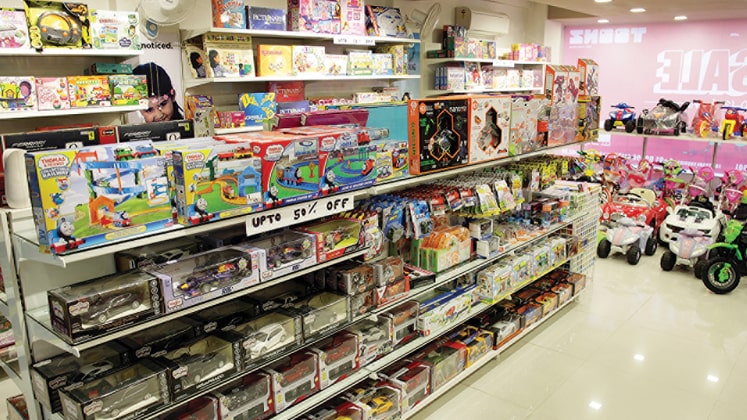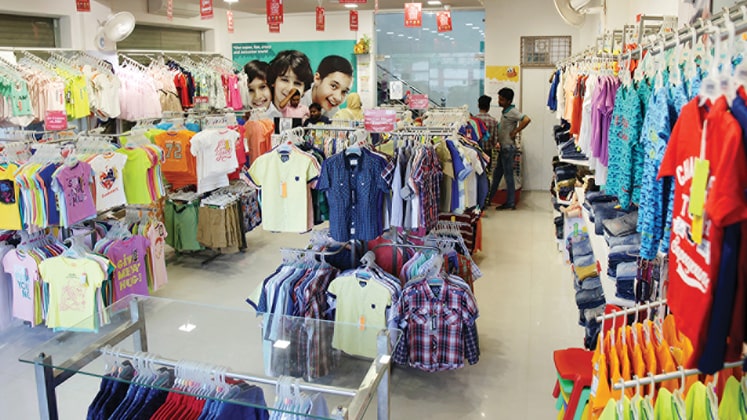
Founded in 2010, Toonz is a one-stop solution for all kids’ needs. What started off as a business based on licensed cartoon character merchandising, now boasts of over 107 multi-brand stores spanning 15 states in the domestic market. Spotting the overlap with other retailers in the cartoon merchandising space, the brand was quick to spot a huge opportunity area in the kids’ segment in India and tap into it.
“Very soon we realised that cartoon merchandise space although a big space isn’t a profitable one. We started looking at some wardrobe studies that made us realise that character merchandise is only 10%-15% of total kid’s wardrobe – and apart from that kids require a lot of other garments as well. We undertook a few feasibility studies and realised that we actually require a pure brand in this space if we want to succeed,” Sharad Venkta, Managing Director at Toonz told Apparel Resources, adding, “Initially we started out by tapping a few brands catering to the kidswear market because we envisioned a multi-brand concept. This move was met with its own set of challenges – somebody was supplying good shirts, somebody was good at T-shirts, somebody was supplying good jeans…, we looked for quality certifications which weren’t available for many of these brands, and regional specifications weren’t met – so we decided on creating our own products. This worked well for us because of our strong network in the domestic scenario which made us realise that captive consumption is good enough for us to start a brand.”

If someone comes to my store and doesn’t find what they’re looking for, they will go somewhere else because there are lot of choices in the market. If I lose a customer once, chances are that I’ve lost him forever.
It was then that Toonz came out with two of its own in-house brands called ‘WOWMOM’ and ‘SUPERYOUNG’ in 2012 with a smart casual range. With 300 pieces per style, WOWMOM focuses on the new-borns up to 3 years segment, while SUPERYOUNG caters to kids in the age group of 3 to 12 years. Taking certain learnings along the way, Toonz understood that there was a big gap in the festive space which could not be catered to by the existing casual range, so they launched a ‘SUPERYOUNG CELEBRATION’ line which includes partywear and ethnic outfits for kids aged from 3 to 12 years.
RETAIL AND PRODUCT HACK
With a diverse range of products catering to such a vast age group, Toonz has an advantage over other brands that makes customers come back to their stores to get what they want – and even what they don’t know they want till they see it at the store. With a ‘No Questions Asked’ exchange policy, customers can exchange a product which has not been used, within 30 days, with an extended exchange policy in genuine cases.
“We are not a cheap brand but we are a value brand. We take certificate for colour grading, for tearing, for nickel-free garments which are all safety standard requirements,” Sharad explained.
As families increasingly become nuclear with every passing day, millennial parents are unequipped with proper information regarding what products are required under which situations. To tackle this issue, Toonz has allocated a ‘Champion’ in the Baby Care Section at every store, who communicates with women shoppers in a manner that they would understand. The brand also employs fashion consultants in the Garments Section who help, guide and suggest new products to customers.
“Nowadays we do Solution Selling; for example, there are various products that go into feeding – you may require a breast pump. If you buy a breast pump, you obviously need a bottle; with the bottle, you need the sterilizer; if you buy the sterilizer, you need to buy the cleaner; you buy a cleaner, you need to buy a brush for that. Similarly, for the process of bathing, you require a baby chair, a potty seat, towel, shampoo, fluoride free baby toothpaste, a brush, retainers for the teeth… there is no end. 46 items go into our New Born Kit,” Sharad elaborated enthusiastically.
Toonz provides another service wherein before going for delivery, ‘mothers to be’ can visit the store and select certain products which are directly shipped to their place post-delivery. This is largely popular in Tier-2 cities because smaller markets have limited choice as compared to metros which are flooded with options.
“There is a retail secret – the mothers or parents want to be lured with certain benefits as consumers. So you need to create excitement which can be of various nature – be it in the form of direct discounting, or in the form of freebies,” Sharad added, saying, “We have a loyalty program where points get added which can be later redeemed. In loyalty, we record the customer’s age as well, so we get certain details such as the baby’s date of birth, etc. We know that if the baby is going to turn 3 years old, the customer still has potential for 9 more years which further helps us to devise a proper communication channel with them. We come to know their birthdays, so we can just wish them, invite them to our store with a special exclusive birthday discount, to keep them hooked.”
New year also poses as a massive opportunity for mothers wherein a lot of forward buying takes place. They prefer buying something which is required from now on extending to the near future.
RETAIL AS A BUSINESS AND PRODUCT MIX
“We call ourself a multi-brand solution store. So if you come to the TOONZ store, you find a one-stop solution for all your kids’ related needs. The offering starts from a diaper and goes up to a mini car which is the most expensive item in our store, priced at Rs. 25,000. Generally our focus remains on a new born – a mother who is due to deliver because that is the time they discover a lot of new things which they need to use,” Sharad told AR.
In the store, there is no brand – there is only product offering. The multi-brand retailer doesn’t push its products to customers. Housing brands such as Chicco, Farlin, Lovelap, Avent, Toonz tries to adhere to its strong policy of being quality certified. “Wherever we find an issue or a complaint about a brand’s quality coming from the customer, we see to it that the brand’s assortments are changed. There are certain regulations which keep coming from the Government’s side, especially in the feeding area, which we ensure that we follow and not promote products that violate these laws,” Sharad added.
The brand provides 450 options per season divided into the core and fashion ranges. The core range has a higher quantity owing to demand and is replenished fortnightly, whilst the fashion range has a lower quantity with no replenishment.
As Sharad explained, “Our entire replenishment happens on two bases, for example we change seasons and after that every month we introduce fresh looking merchandise into our stores. Spring/Summer has two parts to it – one is Spring, which has larger quantities and options – may be 70% options, and the other Summer, which comes with 30% options, thereby refreshing the store again. Certain products are replenished depending upon their performance.”
The mix is not very varied between young girls’ and young boys’ apparel but in the girls’ category, business is more complicated owing to more choices. For example in the boys’ category, one can make shirts for Summer and be done with it, but the girls’ section requires more variety – a successful mix would include skirts, dresses, shorts and within that various options, such as sleeves, lengths, details, etc.
“High-fashion garments for girls sell very well. Girls are not in for basics. You make something nice for them – they will buy it. For the boys, it’s all about basics – from the design point of view, make something funny for them and they will be happy,” Sharad quipped.
The brand follows 5 sizes – in the 0-6 bracket, 6-12, 12-24, 24-36; and in the 3-12 bracket, it does 7 sizes, namely, 3-4, 4-5, 5-6, 6-7, 8-9, 10-11, and 11-12.
Earlier people used to be very dependent on the sizing that was mentioned by individual brands but nowadays it is vital to look at sizes physically and then make a purchase. In the entire kidswear segment, sizes vary considerably and there are a lot of overlaps. From 5-6 to 11-12, many sizes serve multiple age groups/body shapes owing to height and other differences. This isn’t a problem in offline retailing, but in terms of online business, it becomes a challenge.
Buying online is an effort if you don’t know the sizing of the brand in question. If you get it wrong, you have to go through the entire hassle of exchanging and returning – people want to be first time right!
PRICING
The challenge with kids is that they outgrow clothes in the blink of an eye. It is important for brands and retailers to introduce prices that are sharp. With the GDP steadily increasing, Indian consumers nowadays don’t mind shelling out Rs. 5,000 on a garment, but the purchase is not value for money considering the actual number of times the garment will be worn. “We realised that some garments have to be very smartly priced so we introduced price distinguishing – the casual range is available at a certain price point and for the expensive garments, it is imperative for the look to be a certain way and justifiable too,” Sharad elucidated.
Consumer’s expectations today are changing faster than what is being manufactured. Earlier it used to take some time for one style to be in trend in one market before it passed onto another market, but with the advent of science and technology, social media, and especially Instagram, everything has changed. Kids today have an active part to play in purchasing decisions – deeming them to be the primary consumers.
“The user is the child; he/she is defining their own look. Earlier mothers used to be casual about their looks, but nowadays they also like dressing up their kids in accordance with the occasion,” Sharad added.
Mothers come to the store, they select and then they sit. The kid will like something, which might be the most unfit garment for the kid but you know what’s going to get billed? The same garment that is in the kid’s hand.
REGIONAL DIVERSITY
“India, while you may call it one country, there are multiple countries within a state as well. The seasonality factor has to be kept in mind, so what goes to Pune does not go to Rajasthan and what goes to Mahalangur does not go to Telangana – these are the basics of our business,” Sharad stated, explaining the regional diversity of Toonz’s assortments. The brand creates around 65 per cent of the mix as a universal range which goes to all the stores, with the remainder 35 per cent being very selective. They make shorts and half sleeve T-shirts and shirts during winters but only for the south market, largely comprising of Tamil Nadu, Kerala and some parts of Telangana. Kerala and the east are slightly different from the west and the south as they are generally homogeneous in nature in terms of what they wear.
“We’ve been trying to work around the concept of India being a big country and are working on assortments that are region-specific. These require small quantities which we can’t make in our brand – so we buy these from other brands and keep them in our store to ensure that the assortment is complete. For example, we don’t make the entire range of winterwear, we only make a limited part of it, and we outsource the fillers from other brands,” Sharad stated.
You just can’t do smart casual, formal, etc. And get away with that – it has to be very sharp and on point with the changing seasons and occasions. You can’t just keep ethnic in the month of March in the stores because it won’t sell, so you need to be right on time. You also have to provide the right product at the right time, besides your store’s look has to change accordingly. If you don’t do that you will miss the opportunity with the customer.
MANUFACTURING & WAREHOUSING
The brand follows the procedure of contract manufacturing and their lead time from design to store is 9 months. They manufacture everywhere, from Bangalore to Selum, to Tirupur to Indore to Mumbai to Noida to Calcutta, depending on each hub’s expertise. This exercise entails them a good cost advantage and ensures that their products are competent in the market as well. In terms of the brand’s own facility, they have one in Pune and one in Bangalore.
“Because we have a wide variety of ranges, we can’t create multiple facilities – it’s not economically viable. If tomorrow schiflee is in trend, I can’t set up an entire facility with machines that just do schiflee work; so in such cases, outsourcing proves to be more beneficial,” Sharad explained.
Toonz has its mother warehouse based in Hyderabad, which poses as its main distribution centre.
“We don’t do less than 800 sq. feet and we go up to 2,000 sq. feet. Our basic motto is that the rentals should be in control – in smaller markets it always makes sense to have a bigger store because you can look like a branded store without shelling out that much,” Sharad said, commenting on his store sizes.
My personal feeling is that the south is generally friendlier towards organised retail as people are more used to shopping in such environments. Hyderabad and Telangana are very cost-efficient in terms of real estate. They are far more affordable than any other market and space is also widely available. In terms of Government policies and restrictions, Telangana is a moderate space. There are no challenges locally as well – staff availability is good, people are very entrepreneurial. Karnataka is also similar but Bangalore becomes more expensive, as there’s no space left – it’s as good or as badly choked up as Mumbai.
Internationally, Sharad recommends Bangladesh for basics for large quantities but advises against smaller quantity assortments of 50 with 2,000 pieces per style, as it does not end up giving the same price advantage. The brand is exploring opportunities in Bangladesh, while seeing how it can maintain its cost advantage within the Indian market as well.
ONLINE BUSINESS
“I don’t view business as either online or offline; for me there are customers and you have to serve them,” Sharad stated. The retailer is looking at investing in the online sphere but in the meanwhile sells via the marketplace model to various channels.
EXPANSION
“We have been expanding and growing, we recently opened a store in Roorkee, at Kumar Pacific, and we opened a store in Kolhapur and we have been looking at 5-6 more properties now. We have also been putting in a lot of efforts in terms of selling our products through other channels,” Sharad told AR.
The multi-brand retailer expects to reach five states this season, through the general trade market which comprises of Maharashtra, Gujarat, Telangana, Kerala and Mumbai, as Mumbai and Maharashtra are two different states for us.”
The brand is working on expanding the product categories of WOWMOM. The retailer plans for 120 doors by the end of this fiscal.
Internationally, Toonz boasts of five customers including Nepal, Mauritius and Saudi Arabia. These are multi-brand retailers which carry the retailer’s in-house brands. Toonz also has its own three stores in Saudi Arabia through a franchise.








